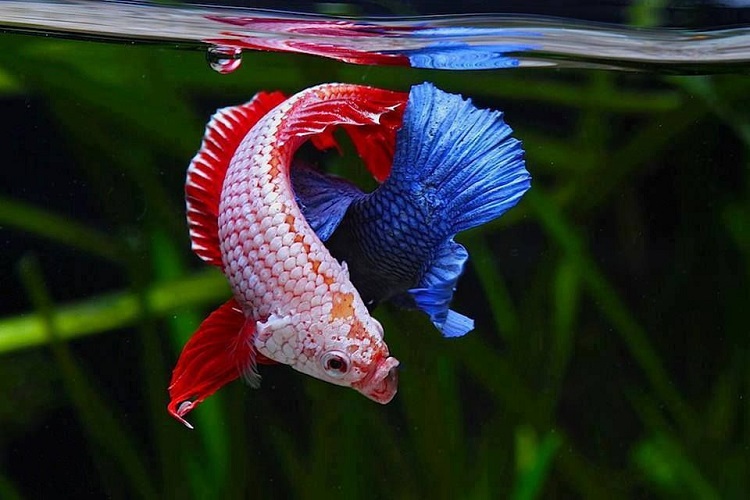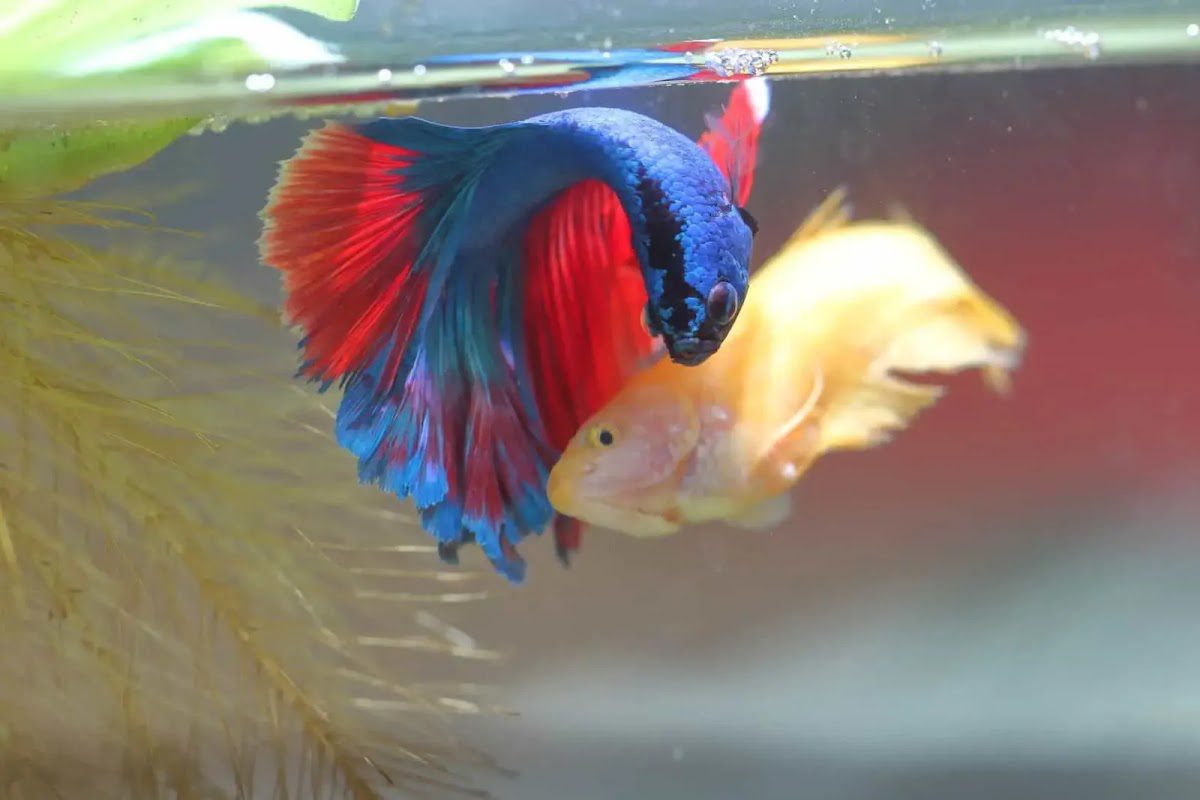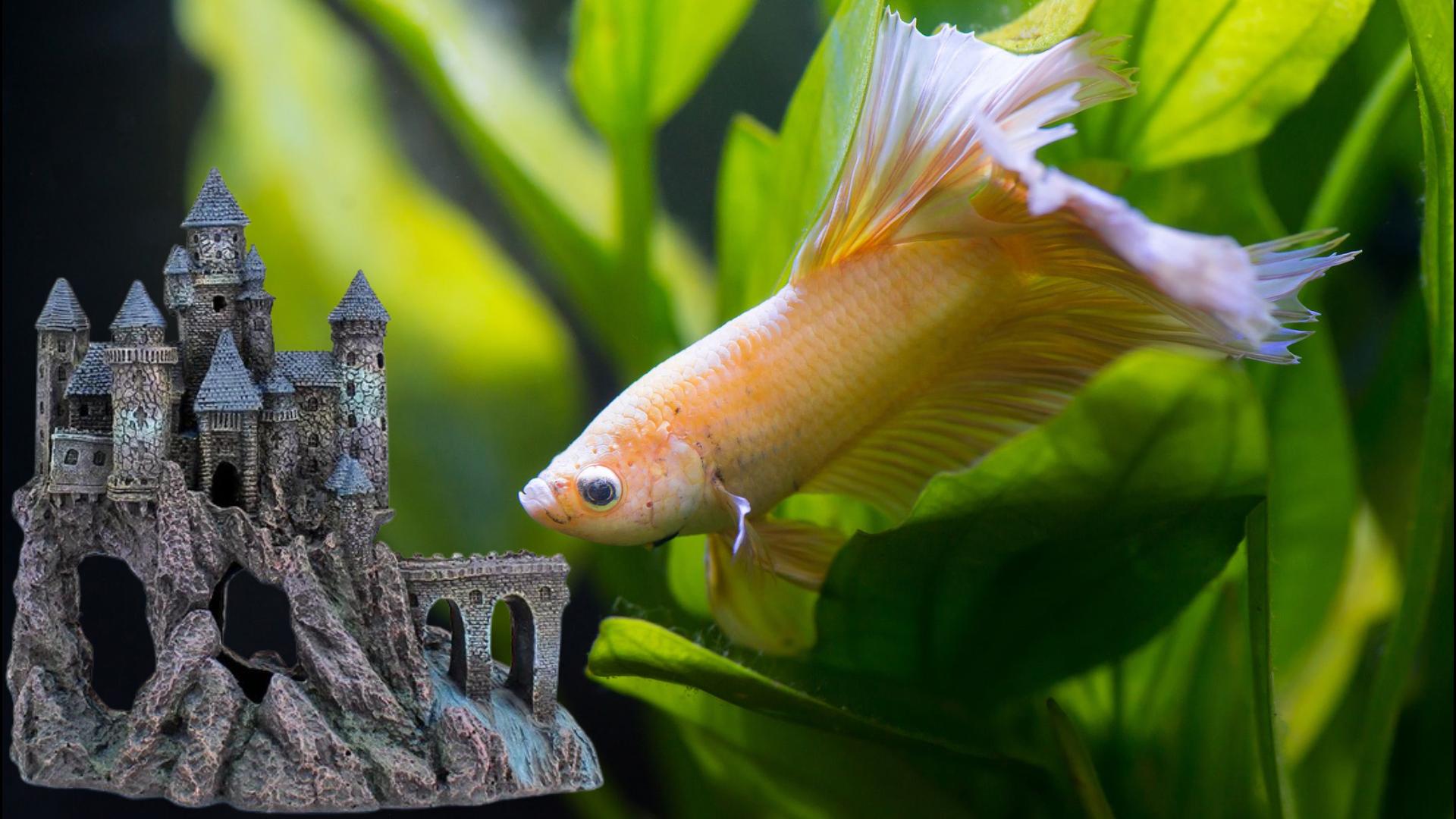Betta fish breeding can be a fascinating and rewarding hobby, but it’s important to understand the process before starting it. In this blog, we’ll explore the ins and outs of breeding betta fish, including everything from selecting your breeding pairs to caring for your new fry.
Betta fish, also known as Siamese fighting fish, are popular aquarium fish known for their vibrant colors and flowing fins. Breeding Bettas is a complex process that requires careful planning and preparation. The first step in breeding bettas is to select your breeding pair. It’s important to choose healthy, mature fish that are free of any illnesses or genetic defects. Look for fish that are active, responsive, and have bright colors and flowing fins. Make sure the betta has no traces of fin rot, which looks like ripped or fuzzy fins with red tips. Male Betta fish require a lot of effort during breeding. Choosing healthy and young betta fish is key to success.

Breeding Betta Fish
Once you’ve selected your breeding pair, it’s time to prepare their breeding tank. Betta fish are known for their aggression, so it’s important to have a large enough tank to keep them separated during the breeding process. I recommend choosing round tubs or at least a 10-gallon tank, as it will give the female betta enough space to run around if the male is aggressive. Fill the tank with clean, dechlorinated water and provide some hiding places for the female betta to retreat to.
Before introducing a breeding pair, it’s important to condition them for breeding. This involves feeding them a high-protein diet and gradually increasing the temperature of the water to simulate the conditions of their natural habitat. After 3- 6 days of conditioning, introduce the male betta to the breeding tank. This will help to male to settle down in the tank and build a bubble nest.
Once the male is in the tank, introduce the female with a glass separator or with the small bottle inside the male tank. This will help male betta to check on females and get ready for breeding, at the same time, it will prevent males from attacking the female. After a few hours, the male must create the bubble nest in your tank.
Once the male builds the bubble nest and becomes non-aggressive towards the female, introduce the female to the tank by removing the glass separator. It’s common for males to try to attack the female at this point. It’s part of the breeding process for males to make females submissive. Keep a close eye on their behavior and watch for too much of aggression. If the male betta shows signs of aggression towards the female over a few hours, remove him from the tank and try again later.
When a male betta welcomes a female…
When a male betta welcomes a female, he proudly presents his bubble nest on the water’s surface. The female inspects it, signaling her readiness to mate. The male’s courtship continues as he entices her to visit. Upon her arrival, he embraces her, prompting her to release eggs and himself to release milt, fertilizing the eggs. The male diligently guards these eggs for days until they hatch. He remains their fierce protector even after hatching, ensuring their safety. Any stress or distractions can lead to spawning failure or egg consumption, resulting in breeding failure.
Once the female has laid her eggs, removing her prevents potential aggression from the male. The male betta takes up the role of caring for the eggs, safeguarding them, and maintaining their warmth by incessantly blowing bubbles into the nest.
After a few days, the eggs hatch, and the fry emerge. It’s crucial to relocate the male betta at this stage to prevent him from consuming the fry. The fry requires frequent feeding, with options like baby brine shrimp or powdered fry food. Maintaining clean, well-oxygenated water in the tank is equally important.
As the fry grow, they must be separated into individual tanks to prevent overcrowding and food competition. It may take several months for the fry to reach maturity, showcasing their full colors and fins. Once mature, you can keep them as pets or sell them to fellow betta enthusiasts.
Breeding betta fish presents challenges but offers rewarding experiences. By thoughtfully selecting breeding pairs, preparing their breeding tank, and providing proper care and nourishment for the fry, you can raise healthy, captivating betta fish that bring beauty and joy to your home or aquarium.
Now lets look preparation steps that requires for betta fish breeding. Breeding betta fish can be an exciting experience, but it’s essential to understand the signs of readiness in both male and female betta fish for breeding. This section shows you how to identify when your betta fish are ready for breeding.
Is Your Female Betta Fish Matured?
If you’re considering a female for breeding, it’s essential to understand the key indicators of her readiness. First and foremost, female betta should be at least 4 to 6 months old before breeding. When a female betta is receptive and ready to mate, she may display a small white spot near her ventral fin, known as the “egg spot”. This spot helps release eggs during spawning. You may observe that the female’s belly swells. Her swelling indicates that she is filling up with eggs, ready for spawning. Lastly, note her activity level. Healthy breeding-ready females are active and energetic. You’ll often find them swimming around the tank, exploring their environment, and showing an interest in their surroundings.
How to Know Your Betta Fish Are Ready For Breeding?
Once you’ve identified a female ready for breeding, it’s equally important to find a male betta that’s in the right condition. Make sure to check out this blog about conditioning betta fish for breeding before your next breeding session. Let’s move on to male betta fish now.
Similar to female betta, male betta should also be at least 4 to 6 months old before breeding. Additionally, I recommend avoiding betta fish older than 14 months since their breeding process may be exhausting for them. Next, observe the male’s colors, which often provide a clue about his breeding condition. Breeding-ready males typically display more vibrant and intense colors. One of the most significant signs that a male betta is ready for breeding is his instinctive bubble nest building. As we can see here, our male has already constructed a bubble nest at the water’s surface. This fascinating structure, made from air bubbles, saliva, and plant materials, serves as a safe haven for eggs during spawning. A well-constructed bubble nest is a clear indication that the male is fully prepared to breed.
Healthy male betta are also highly active and alert. As you can observe, our male swims energetically around his tank, showing a keen interest in his environment. An active and engaged demeanor is another positive sign of his breeding readiness.
Things must know!
Now that you know how to identify both male and female betta ready for breeding, it’s time for a quick reminder. Do not breed too young or unhealthy betta. Ensure both the male and female are in optimal condition. Create a suitable breeding environment with plenty of hiding spots, plants, and soft water for successful breeding. Always supervise the breeding process. Betta can be aggressive, and the male may harm the female. Once spawning is complete and all eggs are released, remove the female from the breeding tank to prevent aggression. Remember to be patient. Also, it’s important to make multiple attempts to get things exactly right for betta fish breeding success.
Choosing the correct betta fish pair
Choosing the correct betta fish pair is key to your breeding process, guaranteeing 75% of success. It is important to consider a number of key factors when selecting betta pairs for breeding. In this post, we discuss how to choose the right pair of betta fish to get the best quality betta fry with vibrant colors.
Before we begin, I would first like to thank you for checking out my channel. We post interesting blogs about aquarium fish every week.
Where to buy breeding pairs
You can purchase betta fish from either pet shops or reputable breeders. If you want to be successful and reduce the risk of breeding failures, you should buy from a reputable breeder rather than your pet store. You won’t know their genetics or age if you buy from a pet shop, which drastically reduces your success in breeding.
Betta fishes breed best when they’re 4 to 12 months old, and if you end up with poor genetics or the incorrect age, the fry could end up being sickly or undesirable. A reputable breeder will be able to provide you with all the information you need. Additionally, you can ask them how they successfully bred their Betta fish.
You can find quality betta breeders through organizations like the International Betta Congress or through Facebook groups. Ask your friends or family members who breed betta fishes or are familiar with them for suggestions.
Choosing your optimal betta pair – Breeding Betta Fish
Betta fish’s qualities like health, beauty, fin type, and patterns are genetically determined. Select your betta fish carefully based on the qualities you wish to achieve. All of these factors are crucial for the production of quality fish, as well as preventing the generation of unhealthy fish.
It’s critical to examine the fins for traits you want to breed and potential injuries. Check the caudal, tail, fin for straightness and curvature. The caudal fins of good breeding stock betta fishes should be straighter and curved in opposite directions. The more branches or splits you have, the more supportive, larger, and beautiful finnage you will get.
Determine whether your betta pair is matured
In order for your betta fish to breed successfully, they should be aged between 4 – 12 months. The chances of your betta fish breeding are meager if they’re not in this range. Immature females can’t lay eggs. Therefore, less than a 4-month-old female can’t be bred. Also, make sure you don’t consider older females because they can’t release eggs.
You can easily confirm the adultery of betta fish. One of the most obvious indicators that your male betta fish is mature enough to breed is its ability to create bubble nests. A female betta fish should have a visible egg spot and a substantial stomach containing eggs. It’s essential to get fish that are the same size. Always avoid choosing a female Betta that is larger than your male. A bigger female may make your male unable to wrap around the female to release its eggs. This will make your breeding process fail.
Combine complementary colors
Betta fishes come in a variety of colors. Choose colors that complement each other or that you like as mates for your betta. Be aware that bettas come in colors such as red, orange, yellow, turquoise, steel blue, or royal blue. They can also have black or iridescent features. So if you are a serious breeder, try to understand the color combinations and genetics to produce quality betta fry.
Check for Betta fish health
Make sure the betta has no traces of fin rot, which looks like ripped or fuzzy fins with red tips or near the tears. Be sure the betta fish are healthy and active before breeding them. Male Betta fish require a lot of effort during breeding. Choosing healthy and young betta fish is key to success. Also, make sure there are no signs of infections or illness on the betta. If interested, find out more about betta diseases and simple treatments on my channel page.
Healthy diet before breeding – Breeding Betta Fish
Breeding can stress and exhaust your betta pair. In order to optimize the breeding process and ensure the health of the eggs and fry, make sure they are fed a healthy diet before they start breeding. You should feed the brine shrimp, blood worms, and flake food for at least a few days before breeding to prepare them. You should feed them once a day to prevent constipation and excess food from spoiling the water.
It is not so simple to get genetic quality at the first attempt on traits you want. Betta breeding usually takes 5-10 attempts to get quality fries, then you can start over again and introduce new genes to make another variety. If your first-time fries aren’t that vibrant, try picking the best from the lot and redoing the process with a similar female. Remember that if you’re hoping to achieve a certain goal through your selective breeding, either with fin size or color, it can take a few cycles for these traits to fully appear.
8 Betta fish breeding Mistakes To Avoid
Now, let’s look at the breeding mistakes to avoid. Breeding betta fish and raising betta fries are the most exciting parts of betta fish keeping. However, even the most experienced breeders sometimes have problems breeding betta fish if they don’t follow the process correctly. In this blog, we will see 8 common mistakes that you should avoid when breeding betta fish to increase your chances of successful breeding. Let’s get started.
#1. Picking the wrong betta fish.
The male and female Betta fish need to be compatible to breed. Often, betta fish won’t breed if they are not compatible with their mate. Observe whether your betta fish makes bubble nests in its tank. Male betta fish need to build quality bubble nests to attract females when they get ready to mate. There’s a very good chance the male isn’t ready to mate yet if he doesn’t make a bubble nest or if it’s poor quality.
Females with whitish egg spots on their undersides are mature for breeding. There’s a chance a female Betta won’t be able to breed if she doesn’t have a visible egg spot.
A male betta fish can kill a female betta fish if it is too aggressive. You should avoid male betta fish that are too aggressive all the time. A female betta fish that is aggressive can be considered to breed since she will be able to sustain herself better against a male.
You should also avoid picking a female betta fish that is larger than a male betta fish. In some cases, this causes the male to be scared of the female. In addition, male betta fish will have difficulty wrapping their body around the female. So, picking a smaller male against a larger female makes it hard to mate.
#2. Bad tank and water conditions – Betta fish breeding
The breeding tank environment plays a very important role in the process of breeding betta fishes. If your tank water parameters and temperature are not comfortable, betta fishes may show less interest in breeding. Even if they spawn, the eggs will not develop normally in bad water conditions. As a result, the eggs may catch fungus and die.
Make sure your tank is heated to 74° to 79°F for optimal comfort and metabolic efficiency. Cold water will not provide the best breeding environment.
Keep the breeding tank conditioned by adding an antibacterial solution or almond leaves. I usually add a pinch of salt to my mating and grow-out tank. Keeping the water clean prevents eggs from growing fungus and fries from dying.
#3. Betta is too young or old
It’s important to have your betta fish between the ages of 4 – 12 months to breed. It can be a problem if your bettas aren’t in this range because the chances of them breeding are very low. Immature females can’t lay eggs. Therefore, less than a 4-month-old female can’t be bred. Also, you should avoid considering older females as they can’t release eggs due to aging.
On the other hand, breeding with younger male bettas will produce more fry. The breeding process takes a lot of effort for male betta fish; so usually older betta fish can’t stand and get sick sometimes during the process.
#4. No proper conditioning – Betta fish breeding
Betta fish will not breed successfully if they are not conditioned properly before breeding. It is highly recommended to feed betta fish for at least 2 weeks with nutritional products such as daphnia, bloodworms, brine shrimp, or other high-protein foods. Especially, male betta fishes don’t eat while spawning is in progress; so it’s very important to prepare them with a proper diet before breeding.
Also, don’t ever release female betta fish right away into the tank. Always consider introducing female betta fish in a glass container inside the male’s tank to get them conditioned. Once the male betta settles down with the female by creating a bubble nest, release the female betta fish. Failure to follow this step may result in an unsuccessful breeding attempt.
#5. Disturbing the tank
Keep checking the tank frequently is one of the most common issues for beginners which results in breeding failure. Do not keep checking on your fish every few minutes. This will make them stressed in the breeding tank. Stressed betta fish will not spawn. Also, avoid keeping the tank lights on all the time. Of course, they need some privacy and no stress during the mating process.
#6. Separating betta male quickly or late – Betta fish breeding
Separating male betta fish from the tank must happen at the right time. After around 36 hours, the fry will start to wiggle out of their bubble nests. It’s too soon for them to hatch, and the male betta will catch them and put them back in the nest. During this time, the male betta will hang around beneath the bubble nest, keeping an eye on his babies. The betta fry should hatch after around four days. Also, the fry will land on the bottom of the tank sometimes until they get familiar with swimming. Here again, the male betta helps the fry to start swimming which is critical. Once most of the fry are hatched and started swimming, At this point, it’s best to take male betta fish out of the tank, as he may try eating his children.
Don’t get panicky and remove the male betta fish when you notice him eating eggs. This is also the most common reason for ending up with very little fry from the breeding event. There are several reasons why males eat eggs. Males will eat them if they aren’t fertilized. This prevents fungus from growing and killing other fertilized eggs. Males may also eat eggs that do not develop properly as they are growing. It is part of the breeding process.
#7. Removing the Female Betta fish late
Upon laying all the eggs, the male will let go of the female and begin taking the eggs to the bubble nest. It’s time to remove the female. Because some females do eat their eggs. There’s no need for a female to stay in the tank since only the male cares for the eggs. If you keep female fish in a tank after this point, you might not get as many fry.
#8. Feeding mistakes – Betta fish breeding
It’s best not to feed the male until the eggs have hatched. Usually, male betta fish eat unfertilized eggs during the breeding process to keep the tank healthy. Feeding food may result in the creation of ammonia and fungus in the tank which may kill eggs and fry. Betta fry must be fed with micro food options like baby brine shrimps, infusoria, and micro-worms that can be consumed by those tiny creatures. Must avoid pet-store artificial food products which can’t be hard to digest and result in death.
Do you know any other common breeding mistakes? Have you had any issues breeding betta fish? Please let us know what you think in the comments section below. Thank you for checking. See you in the next post.





